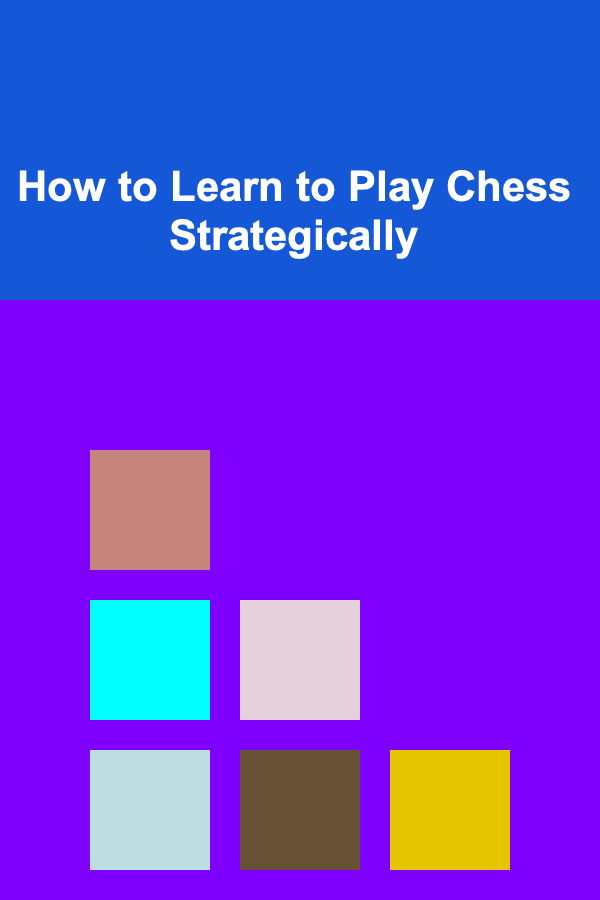
How to Learn to Play Chess Strategically
ebook include PDF & Audio bundle (Micro Guide)
$12.99$9.99
Limited Time Offer! Order within the next:

Chess, often described as a war game played on a board, transcends mere tactical calculations and rote memorization. True chess mastery lies in the realm of strategic thinking. While tactical prowess is essential for capitalizing on immediate opportunities, strategic understanding allows you to shape the game to your advantage, plan long-term, and ultimately increase your chances of victory. This article delves into the multifaceted process of learning strategic chess, providing a comprehensive guide for aspiring chess players seeking to elevate their game beyond the tactical level.
Understanding the Fundamentals of Chess Strategy
Before diving into advanced concepts, it's crucial to establish a solid foundation in the basic principles that underpin all strategic decisions. These fundamentals serve as the building blocks upon which more complex strategies are built.
Piece Activity and Development
The cornerstone of strategic chess is ensuring your pieces are active and contributing to the overall game plan. This starts with efficient development in the opening. Avoid moving the same piece multiple times in the opening unless absolutely necessary, and prioritize bringing your minor pieces (knights and bishops) into play early. Control of the center, while not always paramount, is generally desirable as it allows your pieces to exert influence over a larger portion of the board.
Consider the following example. A common opening mistake is to excessively move pawns in the opening before developing pieces. This can lead to a cramped position and allow your opponent to seize the initiative.
Pawn Structure
Pawns, often underestimated, are the skeletal framework of the chessboard. They define the boundaries of piece activity, create weaknesses, and influence long-term strategic considerations. Understanding pawn structures is absolutely critical for playing strategic chess. Here are some key concepts:
- Pawn Chains: A chain of pawns supporting each other. Generally, you want to attack the base of your opponent's pawn chain.
- Isolated Pawns: A pawn with no friendly pawns on adjacent files. Isolated pawns can be weaknesses, particularly in the endgame, as they require constant protection.
- Passed Pawns: A pawn that has no opposing pawns to prevent it from advancing to the eighth rank and promoting. Passed pawns are incredibly valuable, especially in the endgame, as they can force the opponent to dedicate resources to stopping their advance.
- Doubled Pawns: Two pawns of the same color on the same file. Doubled pawns can be a weakness, restricting mobility and creating vulnerability, but they can also control important squares.
- Hanging Pawns: Two adjacent pawns that are not supported by other pawns. These can be both a strength and a weakness. They offer a strong outpost for pieces, but also require constant protection.
Learning to recognize and evaluate pawn structures is essential for formulating strategic plans. For example, if your opponent has an isolated queen pawn, you might aim to exchange pieces to make it more difficult for them to defend it in the endgame.
King Safety
Protecting your king is paramount. While active piece play is crucial, neglecting king safety can lead to devastating attacks and swift defeats. Castling early is generally advisable to tuck your king away in a safer corner. Be mindful of open files and diagonals that could potentially be used for attacks against your king. Consider the pawn structure in front of your king; a weakened pawn shield can make your king vulnerable.
Endgame strategy also requires careful king placement. An active king can be a powerful attacking and defending piece.
Space Advantage
Having more space on the board allows your pieces greater mobility and flexibility. A space advantage can be particularly significant in closed positions, where maneuvering is restricted. Controlling more space often translates to a strategic advantage, making it easier to develop attacks and defend against threats.
Developing Key Strategic Skills
Beyond understanding the fundamental principles, strategic chess requires cultivating specific skills that enable you to analyze positions, formulate plans, and adapt to changing circumstances. Here are some key areas to focus on:
Positional Evaluation
Positional evaluation is the art of assessing the relative strengths and weaknesses of a given position. It involves weighing factors such as piece activity, pawn structure, king safety, space control, and material balance. A good positional evaluation is the foundation upon which sound strategic plans are built.
To improve your positional evaluation skills, practice analyzing positions without calculating specific variations. Focus on identifying the key features of the position and assessing their relative importance. Ask yourself questions like:
- Which side has more active pieces?
- Which side has a better pawn structure?
- Which side has a safer king?
- Which side controls more space?
- Are there any weak squares or outposts?
- Are there any potential threats or opportunities?
By consistently practicing this type of analysis, you will develop a better understanding of the subtle nuances of chess positions and improve your ability to make informed strategic decisions.
Planning and Goal Setting
Strategic chess is about formulating a long-term plan and working towards specific goals. A plan provides direction and purpose to your moves, preventing you from drifting aimlessly. Your plan should be based on your positional evaluation and should take into account the strengths and weaknesses of both your own and your opponent's position.
When formulating a plan, consider the following:
- What are your immediate goals? (e.g., develop a piece, control a key square, improve your king safety)
- What are your long-term goals? (e.g., attack the king, win material, advance a passed pawn)
- How can you achieve these goals? (e.g., by maneuvering your pieces, creating pawn weaknesses, exploiting tactical opportunities)
- What are your opponent's likely plans, and how can you counter them?
Be prepared to adjust your plan as the game progresses. Chess is a dynamic game, and unforeseen events can force you to adapt your strategy.
Prophylaxis
Prophylaxis is the art of preventing your opponent from carrying out their plans. It involves anticipating potential threats and taking measures to neutralize them before they materialize. Prophylactic thinking is a hallmark of strong chess players.
To develop your prophylactic skills, constantly ask yourself: "What does my opponent want to do?" and "How can I stop them?" This might involve defending a vulnerable piece, blocking a key square, or creating a counter-threat.
For instance, if you see your opponent maneuvering a knight towards a weak square near your king, you might consider moving a pawn to defend that square or exchanging the knight for a less valuable piece. Prophylaxis is about actively shaping the game to prevent your opponent from gaining an advantage.
Endgame Technique
The endgame is often where strategic advantages are converted into victories. A solid understanding of endgame principles is essential for any serious chess player. Key endgame concepts include:
- King Activity: In many endgames, the king becomes a powerful attacking and defending piece.
- Passed Pawns: Passed pawns are incredibly valuable in the endgame. Creating and advancing a passed pawn is often the key to victory.
- Opposition: Understanding the concept of opposition is crucial for maneuvering your king in king and pawn endgames.
- Triangulation: A technique used to gain the opposition in king and pawn endgames.
- Rook Endgames: Rook endgames are notoriously difficult. Understanding key concepts such as the Lucena position and the Philidor position is essential.
Studying endgame theory and practicing endgame positions is crucial for developing your endgame technique. Even a small advantage in the endgame can be decisive if you know how to exploit it.
Effective Learning Strategies
Learning strategic chess is a continuous process that requires dedication, patience, and a willingness to learn from your mistakes. Here are some effective learning strategies to help you on your journey:
Study the Classics
Learning from the masters is an invaluable way to improve your strategic understanding. Study the games of legendary players like Capablanca, Alekhine, Fischer, and Kasparov. Pay attention to their strategic decisions, their pawn structures, and their overall game plans. Annotated game collections are particularly helpful, as they provide insights into the players' thought processes.
Focus on understanding the why behind each move, not just the move itself. Why did the player choose to move that piece to that particular square? What was their plan? How did their opponent respond? By analyzing the games of the masters, you will gain a deeper appreciation for the nuances of strategic chess.
Analyze Your Own Games
Analyzing your own games is perhaps the most effective way to learn from your mistakes and improve your understanding of chess strategy. After each game, take the time to review it carefully, preferably with a chess engine or a stronger player.
Identify the key turning points in the game and try to understand why you made the decisions you did. Where did you go wrong? What could you have done differently? Don't be afraid to be critical of your own play. The more honest you are with yourself, the more you will learn.
Pay particular attention to the strategic aspects of the game. Did you develop your pieces efficiently? Did you create a sound pawn structure? Did you formulate a coherent plan? By analyzing your own games, you will gain a better understanding of your strengths and weaknesses and identify areas where you need to improve.
Solve Positional Puzzles
Solving positional puzzles is an excellent way to sharpen your positional evaluation skills and improve your strategic thinking. Positional puzzles typically present a position and ask you to find the best move or plan for a particular side. These puzzles focus on strategic considerations rather than tactical calculations.
When solving positional puzzles, take your time and analyze the position carefully. Consider the factors mentioned earlier: piece activity, pawn structure, king safety, space control, and material balance. Try to identify the key features of the position and assess their relative importance. Formulate a plan based on your positional evaluation and try to find the move that best implements that plan.
There are many resources available online and in books that offer a wide variety of positional puzzles. Solving these puzzles regularly will significantly improve your strategic understanding.
Play Regularly and Experiment
Playing chess regularly is essential for solidifying your understanding of strategic concepts and developing your practical skills. The more you play, the more experience you will gain and the better you will become at recognizing patterns and making strategic decisions.
Don't be afraid to experiment with different openings and strategies. Try new things and see what works for you. The key is to be open to learning and to constantly challenge yourself.
Online chess platforms offer a convenient way to play against opponents of all skill levels. Take advantage of these resources and play as often as you can.
Find a Mentor or Study Partner
Having a mentor or study partner can be a valuable asset in your chess journey. A mentor can provide guidance, feedback, and support, while a study partner can help you stay motivated and accountable.
Look for a stronger player who is willing to share their knowledge and experience with you. Ask them to review your games, offer suggestions for improvement, and challenge you to think critically about your decisions. A study partner can help you analyze positions, solve puzzles, and study chess theory together. The collaborative nature of studying with a partner can make the learning process more enjoyable and effective.
Specific Strategic Concepts to Study
While the above provides a framework, delving into specific strategic concepts is crucial for a deeper understanding. Here are some areas to explore in more detail:
The Isolated Queen Pawn (IQP)
The IQP is a common and complex pawn structure that arises from many openings. It can be both a strength and a weakness. The side with the IQP often has more space and greater piece activity, which can lead to attacking opportunities. However, the IQP can also be a target for attack, particularly in the endgame. Learning how to play with and against the IQP is essential for strategic chess.
Study the typical plans for both sides. The side with the IQP often aims for a kingside attack, using the extra space to maneuver pieces and create threats. The side facing the IQP typically tries to block the pawn, restrict the opponent's piece activity, and eventually attack the pawn itself.
Open Files and Outposts
An open file is a file with no pawns. Open files can be used by rooks to exert pressure on the opponent's position. An outpost is a square that is defended by a pawn and cannot be attacked by an opponent's pawn. Outposts are ideal squares for knights, as they are difficult to dislodge.
Controlling open files and occupying outposts are important strategic goals. Rooks on open files can create threats and restrict the opponent's mobility. Knights on outposts can control key squares and exert pressure on the opponent's position.
King Safety and Attacking the King
King safety is a constant concern in chess. Weaknesses around the king can be exploited by the opponent to launch a devastating attack. Learning how to defend your king and how to attack your opponent's king is crucial for success in chess.
Study different types of attacks, such as direct attacks, sacrificial attacks, and positional attacks. Learn how to identify weaknesses in your opponent's king position and how to exploit those weaknesses. Also, practice building a strong defensive barrier around your own king and learning how to neutralize your opponent's attacks.
Minor Piece Play (Knights vs. Bishops)
The relative value of knights and bishops is a complex topic that depends on the specific position. In general, bishops are stronger in open positions with long diagonals, while knights are stronger in closed positions with limited mobility. However, there are many exceptions to this rule.
Learn how to evaluate the relative strengths and weaknesses of knights and bishops in different types of positions. Consider factors such as pawn structure, open files, diagonals, and the activity of the other pieces. Also, study games where one side has a knight and the other side has a bishop to see how the players exploited the strengths of their respective pieces.
Conclusion
Learning strategic chess is a journey that requires dedication, patience, and a willingness to learn. By understanding the fundamental principles of chess strategy, developing key strategic skills, and employing effective learning strategies, you can significantly improve your chess game and achieve your goals. Remember to study the classics, analyze your own games, solve positional puzzles, play regularly, and seek out mentorship or study partners. Embrace the challenge, and enjoy the process of becoming a more strategic chess player. Good luck, and happy chess playing!

How to Invest in International Markets for Global Growth
Read More
How to Plan an Outdoor Party in Your Backyard
Read More
How to Protect Your Home and Family from Home Invasions
Read More
How to Transform Your Space with Thrift Store Finds
Read More
How to Attend a Foreign Wedding Respectfully
Read More
How to Choose the Right Machine Learning Framework for Your Project
Read MoreOther Products

How to Invest in International Markets for Global Growth
Read More
How to Plan an Outdoor Party in Your Backyard
Read More
How to Protect Your Home and Family from Home Invasions
Read More
How to Transform Your Space with Thrift Store Finds
Read More
How to Attend a Foreign Wedding Respectfully
Read More